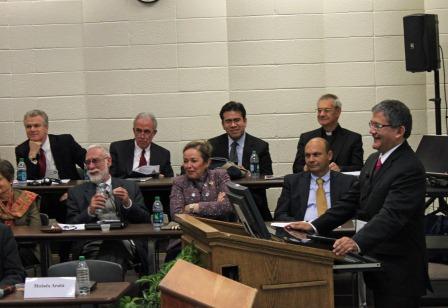Peru

Gaylee Coverston, Research Advisor
Professor Juan Carlos A. Valderrama started the session with a brief historical perspective of government in Peru, touching on the various types of regimes. As he approached the concept of democracy and its development in Peru, he explained that civil and religious societies each have their reasons for existence, however, “Democracy and religion are two different realities and should not have influence on each other.” Professor Valderrama continued to illustrate how the various forms of government and influences from western liberty have lead to the current government committed to a lay state.
The session proceeded with Judge Jorge Luis Salas Arenas presenting a general picture of Peru’s geography and people, as well as an overview of educational, cultural, ethnic and political statistics in Peru. He reviewed the history of Peru’s societies, clearly delineating the influence felt by these societies from their religions. Judge Salas went on to explain what lead to the 1993 constitution which opened the way for religious freedom and diversity. Currently, there are 213 different religious entities registered in the country with 30 more still in the process. In conclusion, he emphasized that Peru, as a multicultural society in both religion and ethnicity, must continue to pursue inclusion and respect for differences.
Professor Moises Arata, the final speaker, discussed Religious Liberty, Human Rights and Democracy in the Peruvian Legal System. He demonstrated how the constitution and articles recognize religious freedom as a fundamental human right. Professor Arata stated that the most important issue is to look at how religious liberty, human rights and democracy can work together to promote a better society. He finished by detailing the pertinent advances for religious liberty as well as the current issues to be addressed.
Thanks to these gracious delegates, the current situation in Peru was clearly presented.